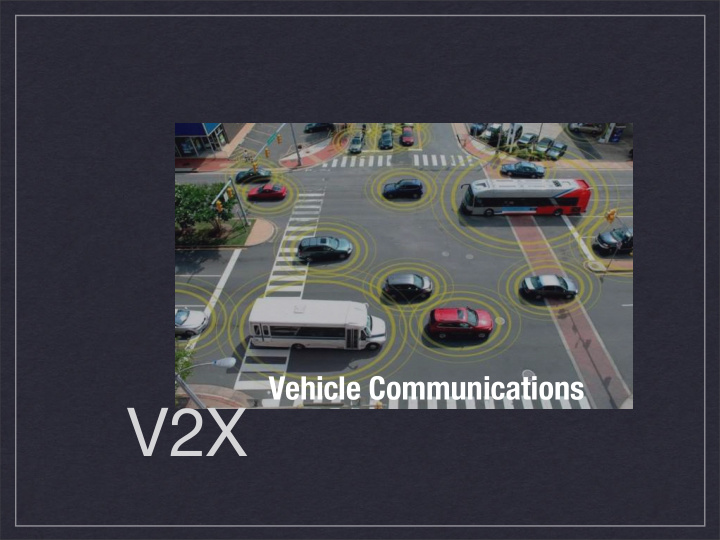



Vehicle Communications V2X
การสื่อสาร V2X V2V (Vehicle to Vehicle), V2I (V to Infrastructure) and V2D (V to device) = V2X (Vehicle to Anything) เพื่อลดอุบัติเหตุ เพ่ิมประสิทธิภาพการเดิน ทาง ลดมลภาวะและพลังงาน เทคโนโลยี m2m, Internet of Things (IoT), DSRC, Radar, Wi-Fi, 3G, LTE, Zigbee, and etc ใช้ใน V2X มาตรฐาน : ISO CALM, IEEE 802.11p (WAVE), ETSI, ARIB. Pictures from DENSO 2
Known Projects/Standards by Orange Lab
V2V application WAVE 4
V2I WAVE 3G Wi-Fi Milimiter- wave IR 802.11a/n LTE INTERSECTION SAFETY ROADWAY DEPARTURE PREVENTION SPEED MANAGEMENT TRANSIT SAFETY AND OPERATIONS COMMERCIAL VEHICLE ENFORCEMENT AND OPERATIONS AT-GRADE RAIL CROSSING OPERATIONS PRIORITY ASSIGNMENT FOR EMERGENCY VEHICLES 5
Traffic Safety Management Warnings on entering Variable speed limits intersections. Adaptable traffic lights Warnings on departing Automated traffic the highways intersection control Obstacle discovery Accommodating ambulances, fire trucks, Sudden halts warnings and police cars Reporting accidents Lane change warnings 6
Driver assistance systems Parking a vehicle Cruise control Lane keeping assistance Road-sign recognition POLICING AND ENFORCEMENT PRICING AND PAYMENTS DIRECTION AND ROUTE OPTIMIZATION TRAVEL-RELATED INFORMATION GENERAL INFORMATION SERVICES 7
V2X World-class Projects http://www.worldstandardscooperation.org/fnc2013.html “Fully Networked Car 2013 – The Future of Vehicles” is being held 6 March 2013 Geneva International Motor Show by IEC ISO and ITU Connected Vehicle Research http://www.its.dot.gov/connected_vehicle/connected_vehicle.htm 8
Car 2 Car Communication Consortium (C2CCC) The communication technology for cooperative ITS and Car-2-Car Communication is derived from the standard IEEE 802.11, also known as Wireless LAN and a frequency spectrum in the 5.9 GHz range has been allocated on a harmonized basis in Europe in line with similar allocations in USA. http://www.car-2-car.org 9
V2X Standards 10
V2X Stakeholder ผู้สร้าง / ดูแล Infrastructure ผู้บังคับใช้ User Vehicle Regulator Developer ผู้ผลิตรถ Telecom Telecom Operator Regulator ผู้ผลิต Telecom manufacture regulate operate develop use 12
13
NEED SOLUTION New paradigm to solve Wireless Communication road safety and traffic between vehicle and others congestion problems. under v2x standard. DIFFERENT BENEFIT Wireless communication in Reduce accident and vehicle environment is increase transport different from Wi-Fi and performance in a smart mobile phone environment. and effective way. 14
ประเทศไทยกับ V2X ทั่วโลกมุ่ง V2X ไปที่ Road Safety ซึ่งโจทย์แต่ละประเทศ ต่างกัน จําเป็นต้องมีการศึกษาวิจัยเฉพาะพื้นที่ V2X คาบเกี่ยวก . อุตสาหกรรม ก . คมนาคม ก .ICT ก . วิทย์ฯ รวมทั้ง กสทช . และภาคเอกชน เป็น Value Chain ขนาด ใหญ่ ต้องมีหน่วยงานกลางประสาน ขับเคลื่อน V2X กับมาตรฐานในประเทศไทยควรจะเป็น IEEE 802.11p และความถี่ 5.9 GHz V2X เป็นโอกาสสร้างนวัตกรรม ITS ตอบโจทย์ประเทศ และก้าวสู่ผู้นําในตลาด ASEAN 15
Back up Slides 16
Radio Spectrum 17
Radio Spectrum 5.85-5.925 GHz FIXED FIXED SATELLITE (Earth-to-space) MOBILE Radiolocation 5.725-5.875 (center freq 5.800 MHz) is ISM. Thailand: 5.725-5.875 GHz 10mW e.i.r.p Radar (license exempted) 18
5 Trends for Road Safety. 1.Less Distracted Driving 2.Gamification and Augmented Reality 3.Autonomous Emergency Braking systems (AEBs) 4.Vehicle-to-Infrastructure (V2I) and Vehicle-to- Vehicle (V2V) communication systems 5. Remove the Human Driver – Autonomous Vehicles TREND AND FORESIGHT BLOG HTTP://INNOVARO.WORDPRES.COM 19
Mobile app Delphi Connected Car โดย Delphi Automotive Systems, LLC 20
21
Time to value for societal and commercial applications 22
ปิดโครงการ มกราคม 2010 23
Comparison
WAVE vs others
IEEE 802.11p unlike 802.11a 5.9 GHz (US), e.i.r.p up to 44.8 dBm (30W). 75 MHz is divided into seven 10 MHz (reduce Doppler spread effect). Control channel (safety message) and Service channel (lower priority). Use double guard bands to reduce Inter Symbol Interference caused by multi-path propagation.
Why WAVE? Highly dynamic topology Frequently disconnect network Highly delay constraint Road environment (tall building) Provide mobile-mobile as well as mobile-roadside communication
WAVE Two types of devices: Road Side Unit (RSU) and On- Board Unit (OBU). OFDM, multiple of 3 up to 27 Mbps in 10 MHz channel. MAC layer (IEEE P1609.4) is multi-channel operation standard. CCH (Control CHannel for safety) and SCH (Service CHannel). Support IPv6 and WAVE Short Message Protocol (WSMP).
Control Channel (CCH) Broadcast communication Dedicated to short, high-priority, data and management frames Safety-critical communication with low latencies Initialization of two-way communication on SCH
Service Channel (SCH) Two-way communication between RSU and OBU or between OBUs For specific applications, e.g. tolling, internet access Different kinds of applications can be executed in parallel on different service channels
WAVE safety and non-safety WAVE Short Message Protocol (WSMP) Used on both Control and Service Channels No setup required Limited to 1400 bytes Limited to WAVE-aware devices IPv6 Used on Service Channels only Allows access to generic applications and networks
WAVE PHY layer IEEE 802.11p PHY: IEEE 802.11a: OFDM (3 to 27 Mbps) at 5.9 GHz MAC: IEEE 802.11e (CSMA/CA) for QoS, No access point functionality Introduces a random local MAC address Allows communications either with or without a WAVE Basic Service Set (WBSS)
WAVE MAC layer IEEE 1609.4 Multichannel operation: CCHs Provides frequency band coordination and management within the MAC layer Time-division channel coordination No more association, authentication, probe request (scan) in Management frames
WSMP IEEE 1609.3 WSMP (WAVE short message protocol) for safety application Reduced overhead: WSMP has 11 bytes of overhead Allows applications directly control lower-layer parameters
Recommend
More recommend